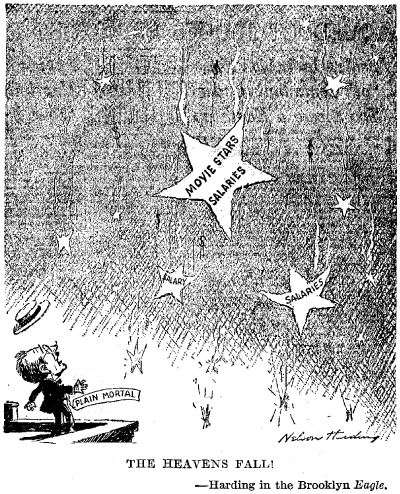In the summer of 1927, the United States movie industry was caught up in a “film economy” drive. Paramount shot first, by demanding a 10 percent cut in salaries from production employees earning over $50.00 per week. The other major studios followed suit. Many saw these moves as evidence of bankers’ increased influence over the studio-producers whose rapid expansion into exhibition they had financed—a “theatrical attempt to impress Wall Street.”1 In July 1927, The Literary Digest noted that the industry was capitalized at $1.5 billion, but that its profit margin was only 4%:
The industry took notice when it went to Wall Street to borrow money for some of its big projects, and struck higher interest rates or was unable to obtain loans. … Not falling off of receipts, but investment bankers’ insistence upon economy, accounts for the policy of cutting salaries which are said to constitute some 60 per cent. of producing expense. Recent big mergers, with the sale of many millions of dollars’ worth of new securities, “have harnessed the play-boy of industries to the chariot of business,” according to L. F. Parton, of the Consolidated Press Association, and a New York Herald Tribune’s pointed news-story head-line reads: “Move for Retrenchment to Stabilize Industry as Picture Stocks Decline.”2

Source: UNZ.org
Cries for “economy”—larger profits, really—weren’t unique to the movie industry. In a Labor Day speech by United States Senator Henrik Shipstead cited Department of Labor statistics showing that “the wage earner has found that his share of the wealth he produced has dropped 30 per cent in six years … and the income of large corporations increased 70 per cent.”3 Income inequality had never been higher—and once the Great Depression struck—it was never higher again until the turn of the century.4
The actors pushed back. The then-new Academy of Motion Picture Arts and Sciences’ various branches offering up plans for streamlining production without salary cuts; the studios backed down.5 In the end, “the only employes hit by the retrenchment were stenographers and others who are not highly paid,” according to Allan Dwan of the Academy.6
As Edwin Schallert wrote in Motion Picture News, the current situation “differs from three or four years ago when the studios were shut down, and the industry seemed to have reached the decision after a period of extravagances that it was better to go back to cheap pictures. Present theatre requirements have naturally made this impossible.”7 Overexpansion would continue unabated until the movie industry started to feel the pinch of the Great Depression—its onset delayed by the popularity of talkies, the relatively low cost of a movie ticket, and other factors.8
As the salary slash fizzled, the company that started the salary slash drive of 1927, Paramount–Famous Lasky Corp., quickly highlighted their progress at economy through other methods.9 Paramount would post a profit of $8,057,997, more than 40% higher than the previous year, and its biggest year to date.10